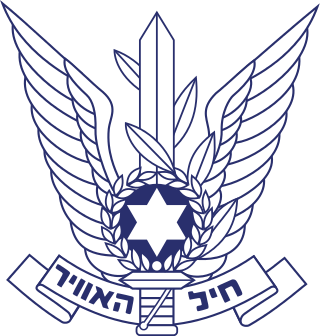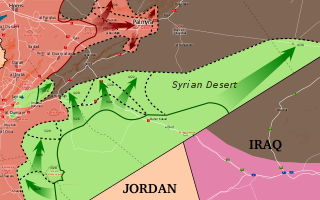
The Israeli Air Force operates as the aerial warfare branch of the Israel Defense Forces. It was founded on May 28, 1948, shortly after the Israeli Declaration of Independence. As of April 2022, Aluf Tomer Bar has been serving as the Air Force commander.

This is a broad timeline of the course of major events of the Syrian civil war. It only includes major territorial changes and attacks and does not include every event.

The History of the Israel Air Force begins in May 1948, shortly after the formation of the State of Israel. Following Israel's declaration of independence on May 14, its pre-state national institutions transformed into the agencies of a state, and on May 26, 1948, the Israeli Air Force was formed. Beginning with a small collection of light aircraft, the force soon transformed into a comprehensive fighting force. It has since participated in several wars and numerous engagements, becoming what has been described as "The mightiest air force in the Middle East".
The Shayrat and Tiyas airbase ambush was an armed attack on Shayrat Airbase and the Tiyas Military Airbase in the Homs Governorate by the Free Syrian Army on 25 November 2011, during the Syrian Civil War. As the Syrian government had banned foreign journalists from entering the country, the exact location of the attack is unknown, although it was believed to have been at a military airbase in Homs Governorate between Homs and Palmyra, possibly at the military airfield at 34°31′30″N37°37′22″E. Ten Syrian Air Force personnel were killed.

The Palmyra offensive of May 2015 was a military operation launched during the Syrian Civil War by the Islamic State of Iraq and the Levant (ISIL) on May 13–26, 2015, in an attempt to capture the government-held Tadmur District of the Homs Governorate, including the administrative centre of Tadmur, known in English as Palmyra. The ruins and ancient monuments of Palmyra, which lie on the south-western fringe of the modern city, have been a UNESCO World Heritage Site since 1980. The ruins were part of a desert oasis that was one of the most significant cultural centers of the ancient world, linking the civilizations of Persia, India, China with the Roman Empire through trade. The offensive was one of the largest offensives launched by ISIL, the largest one conducted by ISIL in Syria since the 2014 Eastern Syria offensive, with the result of the offensive increasing ISIL's control of Syria to at least 50%.
The Palmyra offensive of July–August 2015 was a military operation launched during the Syrian Civil War by the Syrian Arab Army in July 2015, in an attempt to recapture the ISIL-held city of Tadmur, known in English as Palmyra.
The following is a timeline of the Syrian Civil War from January to July 2015. Information about aggregated casualty counts is found at Casualties of the Syrian Civil War.

On 30 September 2015, Russia intervened in the Syrian civil war to fight the Islamic State as part of the war against the Islamic State. This intervention came after a request by al-Assad government for military aid against opposition militias and Islamic State (IS). The intervention was kick-started by extensive air strikes across Syria, focused on attacking opposition strongholds of Free Syrian militias of Revolutionary Command Council and Sunni militias under Army of Conquest coalition. In line with Ba'athist Syrian propaganda which denounces all armed resistance to its rule as "terrorism"; Syrian military chief Ali Abdullah Ayoub depicted Russian airstrikes as facilitating their campaign against terrorism. Russian special operations forces, military advisors and private military contractors like the Wagner Group were also sent to Syria to support the Assad regime, which was on the verge of collapse. Prior to the intervention, Russian involvement had been heavily invested in providing Assad with diplomatic cover and propping up the Syrian Arab Armed Forces with billions of dollars of arms and equipment. In December 2017, the Russian government announced that its troops would be deployed to Syria permanently.

The Palmyra offensive was a military operation of the Syrian Arab Army, supported by Russian airstrikes, to recapture from the Islamic State the city of Tadmur, which was strategically important for both forces due to its position in central Syria. The city was fully recaptured on 27 March.
The Battle of the Shaer gas field was a battle between the Islamic State of Iraq and the Levant (ISIL) and the Syrian government for the control over the Sha'er gas field during the Syrian Civil War. It is the third attack that was launched by ISIL on the gas field.

The Palmyra offensive in December 2016 was a military operation launched by the military of ISIL which led to the re-capture of the ancient city of Palmyra, and an unsuccessful ISIL attack on the Tiyas T-4 Airbase to the west of the city. ISIL previously controlled the city from May 2015 until March 2016.
The following is a timeline of the Syrian Civil War from January to April 2017. Information about aggregated casualty counts is found at Casualties of the Syrian Civil War.

The Palmyra offensive in 2017 was launched by the Syrian Arab Army against the armed forces of the Islamic State of Iraq and the Levant (ISIL) in the Eastern Homs Governorate in January 2017, with the goal of recapturing Palmyra and its surrounding countryside. ISIL forces had retaken the city of Palmyra in a sudden offensive from 8 to 11 December, after previously being expelled from it by Syrian government and Russian forces in March 2016. On 2 March 2017, the Syrian Army alongside Russian reinforcement, succeeded again in recapturing the beleaguered city of Palmyra.

On the morning of 7 April 2017, the United States launched 59 Tomahawk cruise missiles from the Mediterranean Sea into Syria, aimed at Shayrat Airbase controlled by the Syrian government. The strike was executed under responsibility of U.S. President Donald Trump, as a direct response to the Khan Shaykhun chemical attack that occurred on 4 April.
Shayrat Airbase is home to the Syrian Air Force 50th Air Brigade located in Homs. It has two runways and around 40 hardened aircraft shelters.

The Syrian Desert campaign was a large-scale military operation of the Syrian Army that initially started along the highway from Damascus to the border with Iraq against rebel forces during the Syrian Civil War. Its first intended goal was to capture both the highway and the al-Tanf border crossing, thus securing the Damascus countryside from a potential rebel attack. Later, multiple other fronts were opened as part of the operation throughout the desert, as well as operation "Grand Dawn" against ISIL with the aim of reopening the Damascus-Palmyra highway and preparing for an offensive towards Deir ez-Zor.

On 14 April 2018, beginning at 04:00 Syrian time (UTC+3), the United States, France, and the United Kingdom carried out a series of military strikes involving aircraft and ship-based missiles against multiple government sites in Syria during the Syrian Civil War. The strikes were a reprisal for the Douma chemical attack against civilians on 7 April, widely attributed to the Syrian government. The Syrian government called the airstrikes a violation of international law.
The Iran–Israel conflict during the Syrian civil war refers to the Iranian–Israeli standoff in and around Syria during the Syrian conflict. With increasing Iranian involvement in Syria from 2011 onwards, the conflict shifted from a proxy war into a direct confrontation by early 2018.












